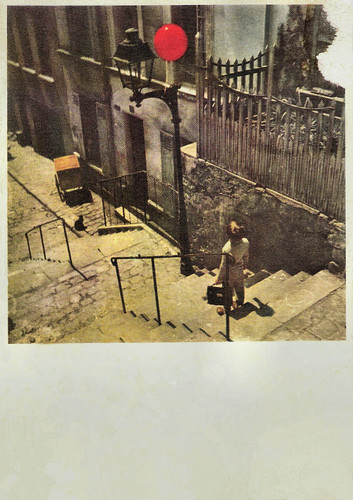
French postcard by F. Hazan Editeur, Paris, no. 1. Photo: Albert Lamorisse, 1956. Pascal Lamorisse in Le ballon rouge/The red balloon (Albert Lamorisse, 1956). Caption: "Decouverte de ballon". (Discovery of the balloon).
French child actor Pascal Lamorisse (1950) is known by film lovers all over the world because of his parts in the short films Crin blanc: Le cheval sauvage (1953) and Le ballon rouge (1956), both directed by his father, Albert Lamorisse.

French postcard by Fernand Hazan ed., Paris, no. 1605 C. French poster for the film Remorques (Jean Gremillon, 1941), starring Jean Gabin and Michèle Morgan. Design poster: Henry Monnier.
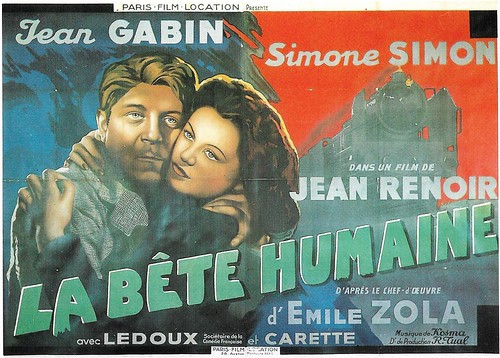
French postcard by Ed. Hazan, Paris. French poster for La bête humaine (Jean Renoir, 1938), starring Jean Gabin and Simone Simon.
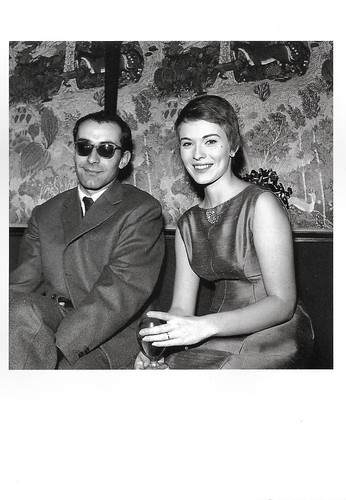
French postcard by Éditions Hazan, Paris, 1996. Photo: Raymond Depardon / Magnum. Caption: Jean Seberg and Jean-Luc Godard after the shooting of À bout de souffle.
American actress Jean Seberg (1938-1979) became an icon of the Nouvelle Vague with her role in Godard’s A Bout de Souffle/Breathless (1960). She appeared in over 30 films in Hollywood and Europe.

French postcard by Éditions Hazan, Paris, no. 6007, 1988. Photo: Sam Levin, 1969. Federico Fellini on the set of Satyricon (1969).
Italian film director and screenwriter Federico Fellini (1920-1993) was one of the most influential filmmakers of all time. He was known for his distinct style that blends fantasy and baroque images with earthiness. In a career spanning almost fifty years, Fellini won the Palme d'Or for La Dolce Vita (1960), was nominated for twelve Academy Awards. He won an Oscar for La Strada (1954), Le notti di Cabiria (1957), 8½ (1963) and Amarcord (1973).
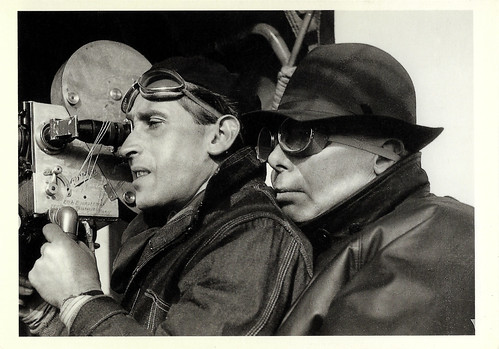
French postcard in the Collection Noire by Editions Hazan, Paris, no. 6011, 1988. Photo: Sam Levin. Jean Renoir at the set of La bête humaine/The Human Beast (1938).
Jean Renoir (1894-1979) was one of the major French film directors before WW II. His films La Grande Illusion/The Great Illusion (1937) and La Règle du Jeu/The Rules of the Game (1939) belong to the masterpieces of French cinema. During the German invasion of France in 1941, he moved to Hollywood where he directed This Land Is Mine (1943), and The Southerner (1945). He later became an American citizen.

French postcard in the Collection Magie Noire by Editions Hazan, no. 6073, 1988. Photo: Madame L'Herbier / SPADEM, Paris. Jaque Catelain in L'inhumaine/The New Enchantment (Marcel L'Herbier, 1924). The exterior of the house of inventor Einar Norsen (Catelain) was designed by architect Robert Mallet-Stevens.
Jaque Catelain (1897-1965) was one of the most well-known faces of the French silent era. Catelain started in cinema with a film written by Marcel L'Herbier, Le Torrent (1917), after which he starred in L'Herbier's first completed film, Rose-France (1918). Catelain became Marcel L'Herbier's fixed actor in the silent era and starred in 12 of his silent films, including L'homme du large, Eldorado, L'Inhumaine and Feu Mattia Pascal.
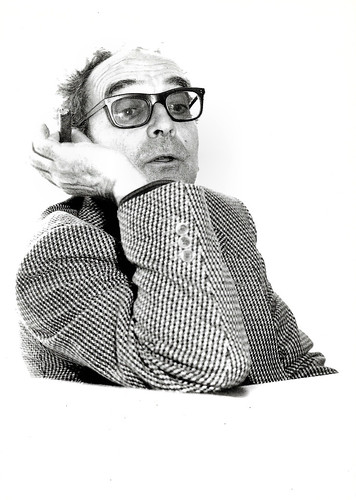
French postcard in the Collection Magie Noire by Éditions Hazan, Paris, 1988, no. 6077. Photo: Pierre-Olivier Deschamps / Agence Vu, Paris. Caption: Jean-Luc Godard, Mai 86.
Jean-Luc Godard (1930) is a French film director and screenwriter. He is one of the most important members of the Nouvelle Vague (New Wave). Godard first received global acclaim for his feature À bout de souffle/Breathless (1959), helping to establish the New Wave movement. Godard's films have inspired many directors including Martin Scorsese, Quentin Tarantino, Robert Altman, Rainer Werner Fassbinder, and Wong Kar-wai. He has been married twice, to actresses Anna Karina and Anne Wiazemsky, both of whom starred in several of his films.

French postcard in the Collection Noire by Editions Hazan, Paris, no. 6109, 1989. Photo: Les films du Carosse, Paris. François Truffaut at the set of Jules et Jim (François Truffaut, 1961).
François Truffaut (1932-1984) was one of the most popular and successful French filmmakers ever. The French film director, screenwriter, producer, actor, and film critic was one of the founders of the Nouvelle Vague and his main themes were passion, women, childhood, and faithfulness. He created such classics as Les quatre cents coups/The 400 blows (1959), Jules et Jim (1961) and La Nuit Américaine/Day for Night (1973). His life and films were mixed up and one of his quotes is "Cinema is an improvement on life".

French postcard in the collection Magie Noire by Editions Hazan, Paris, 1990, no. 6218. Photo: Louis Jouvet in Les bas-fonds/Underground (Jean Renoir, 1936).
Louis Jouvet (1887-1951) was a living glory of the French theatre. He made a huge impact as both a stage director and an actor. His character, his eagle-like profile, and his unique way of speaking made him also an unforgettable film star who appeared in some of the masterpieces of the ‘poetical realism’, the Golden Age of the French cinema.
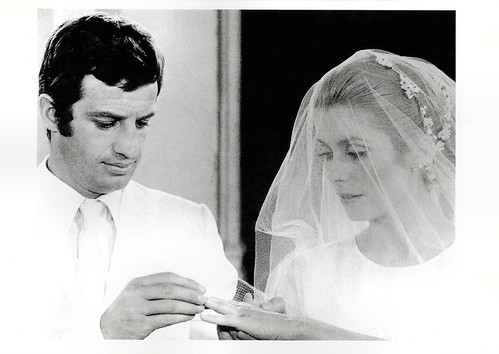
French postcard in the Collection Magie Noire by Éditions Hazan, Paris, no. 6247, 1991. Catherine Deneuve and Jean-Paul Belmondo in La Sirène du Mississipi/Mississippi Mermaid (François Truffaut, 1969).
Jean-Paul Belmondo (1933-2021) was a big comedy and action star in France from the mid-1960s till the mid-1980s, but he was initially associated with the Nouvelle Vague, the French New Wave of the 1960s. Despite his unconventional looks, including a broken nose, he was often polled as one of the sexiest men in the world. For nearly 50 years Belmondo remained one of the most popular and best-loved personalities in France.
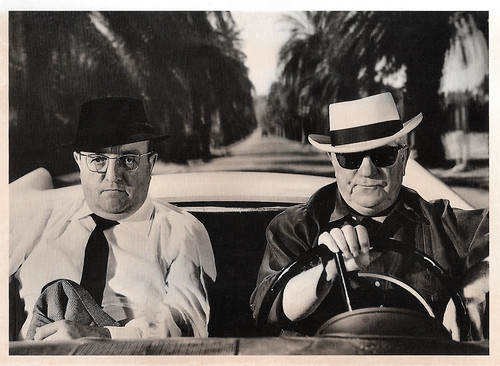
French postcard by Editions Hazan, Paris, 1991, no. 6251. Photo: Bernard Blier and Jean Gabin in Le cave se rebiffe/Money Money Money (Gilles Grangier, 1961).
Stocky, balding Bernard Blier (1916-1989) was one of France's most versatile and sought-after character actors. His complete filmography includes 138 titles, both comedies, and dramas, in France and in Italy.
French actor and war hero Jean Gabin (1904-1976) was one of the great stars of European cinema. In the 1930s, he became the personification of the tragic romantic hero of the poetic realist film. Whether he played the legionnaire (Gueule d'amour), the deserter (Le Quai des brumes), or the head gangster (Pépé le Moko), Gabin was impeccable, bringing tragic humanity to each of his appearances which the public adored. After the war, Gabin was reborn as a tough anti-hero, set in his beliefs, feared and respected by all, the Godfather of the French cinema.
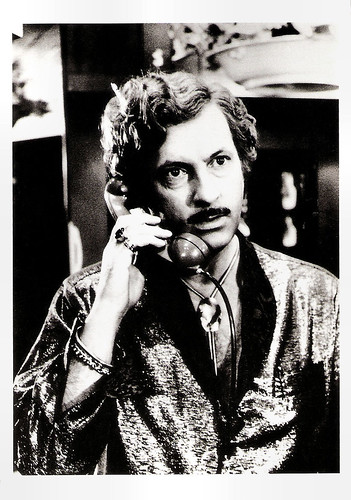
French postcard by Editions Hazan, Paris, no. 6274, 1991. Photo: Edimedia. Michel Serrault in Il lupo e l'agnello/The Wolf and the Lamb (Francesco Massaro, 1980).
French stage actor and film star Michel Serrault (1928-2007) appeared from 1954 to 2007 in more than 150 films. He is best known as Albin Mougeotte, alias the outrageous drag queen Zaza Napoli in the play and the film series La Cage aux Folles (The Bird Cage). In the following decades, the comedian also proved to be a noted dramatic film actor. He would win three Césars - the French version of the Oscar and became one of the grand old men of French cinema.
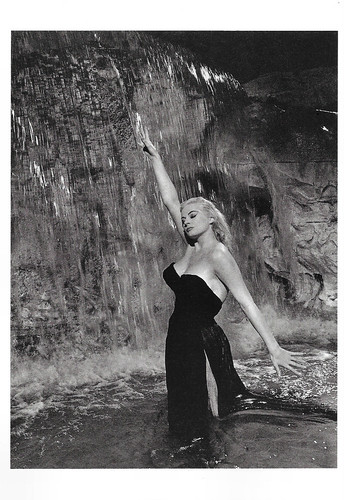
French postcard in the Collection Magie Noire by Editions Hazan, Paris, no. 6323. Anita Ekberg in La dolce vita (Federico Fellini, 1960).
Swedish (but naturalized Italian) film actress Anita Ekberg had a Hollywood career in the 1950s but got her real breakthrough in Italy. As Miss Sweden 1950, she was contracted by studio mogul Howard Hughes. In Rome, she made film history as the sensual, curvaceous film goddess who dances in the Trevi Fountain in Fellini’s La Dolce Vita (1960).

French postcard in the Collection Image Noire by Éditions Hazan, Paris, no. 6332, 1992. Photo: Catherine Faux.
Dennis Hopper (1936-2010) was a multi-talented American actor, director, and visual artist, but also one of the true 'enfants terribles' of Hollywood. In 1970, he won a Golden Palm for Easy Rider (1969) and Hopper was also Oscar-nominated for writing this groundbreaking anthem to freedom and rebellion. In 1987, he received a second nomination for his supporting role in Hoosiers (1986).

French postcard in the Collection Magie Noire by Editions Hazan, Paris, no. 6377, 1993. Photo: Claudine Auger and Sean Connery in Thunderball (Terence Young, 1966).
French actress Claudine Auger (1941-2019) was best known as Bond girl Domino in the James Bond film Thunderball (1965). At 17, she was Miss France 1958 and she became the first runner-up in the Miss World contest. Later she worked mostly in France and Italy.

French postcard in the Collection Noire by Editions Hazan, Paris, no. 6429, 1994. Photo: Raymond Depardon / Magnum Photos. François Truffaut and Jean-Pierre Cargol on the set of L'Enfant sauvage (François Truffaut, 1969).
François Truffaut (1932-1984) was one of the most popular and successful French filmmakers ever. The French film director, screenwriter, producer, actor, and film critic was one of the founders of the Nouvelle Vague and his main themes were passion, women, childhood, and faithfulness. He created such classics as Les quatre cents coups/The 400 blows (1959), Jules et Jim (1961) and La Nuit Américaine/Day for Night (1973). His life and films were mixed up and one of his quotes is "Cinema is an improvement on life".

French postcard in the Collection Magie Noire by Éditions Hazan, Paris, 1994, no. 6430. Photo: Bruno Barbey / Magnum Photos. Jean-Luc Godard, Jean-Paul Sartre and Simone de Beauvoir, 1970.
Jean-Luc Godard (1930) is a French film director and screenwriter. He is one of the most important members of the Nouvelle Vague (New Wave). Godard first received global acclaim for his feature À bout de souffle/Breathless (1959), helping to establish the New Wave movement. Godard's films have inspired many directors including Martin Scorsese, Quentin Tarantino, Robert Altman, Rainer Werner Fassbinder, and Wong Kar-wai. He has been married twice, to actresses Anna Karina and Anne Wiazemsky, both of whom starred in several of his films.
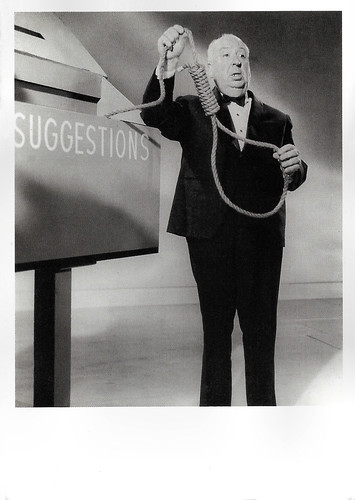
French postcard in the collection Magie Noire by Editions Hazan, no. 6489. Photo: Collection Dominique Lebrun D.R. Alfred Hitchcock promoting Rope (Alfred Hitchcock, 1948).
British director Alfred Hitchcock (1899-1980) was known as 'The Master of Suspense'. He is one of the most influential and extensively studied filmmakers in the history of cinema. He had his first major success with The Lodger (1926), a silent thriller loosely based on Jack the Ripper. Hitchcock came to international attention with The Man Who Knew Too Much (1934), The 39 Steps (1935), and, most notably, The Lady Vanishes (1938). His first Hollywood film was the multi-Oscar-winning psychological thriller Rebecca (1940). Many classics followed including Spellbound (1945), Notorious (1946), Rear Window (1954), North by Northwest (1959), and The Birds (1963). In a career spanning six decades, he directed over 50 feature films which garnered a total of 46 Oscar nominations and 6 wins.

French postcard in the Collection Magie Noire nu Editions Hazan, Paris, no. 6490, 1996. James Stewart, Grace Kelly, and Alfred Hitchcock on the set of Rear Window (Alfred Hitchcock, 1954).
American actor James Stewart (1908-1997) is among the most honored and popular stars in film history. Known for his distinctive drawl and everyman screen persona, Stewart had a film career that spanned over 55 years and 80 films.
American actress Grace Kelly (1929-1982) had a brief but very successful Hollywood career. She was the sparkling, elegant heroine in three classic Alfred Hitchcock thrillers. Her talents rivaled her beauty, winning her the Best Actress Oscar for The Country Girl in 1954. After marrying Prince Rainier III in April 1956, she became Princess of Monaco and retired from the cinema.
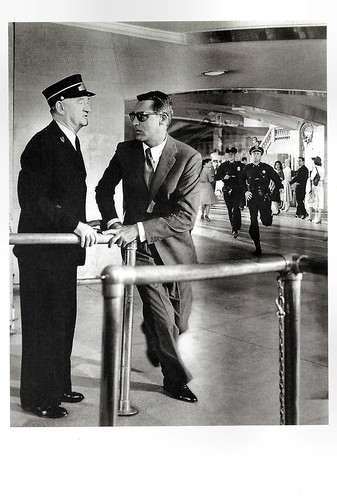
French postcard in the Collection Noire by Editions Hazan, Paris, no. 6492, 1996. Photo: Collection Dominque Lebrun D.R. Cary Grant in North by Northwest (Alfred Hitchcock, 1959).
Handsome, suave English-American actor Cary Grant (1904-1986) became one of Hollywood's definitive classic leading men, known for his debonair demeanour. Grant’s best-known films include Bringing Up Baby (1938), The Philadelphia Story (1940), His Girl Friday (1940), Notorious (1946), An Affair to Remember (1957), North by Northwest (1959), and Charade (1963).

French postcard by Éditions Hazan, Paris. Collection: Carla Bosch (Meiter).
Sophia Loren is an Academy Award-winning - and gorgeous - European film star. La Loren (1934) rose to fame in post-war Italy as a voluptuous sex goddess. She became one of the most successful international stars of the 20th Century.
Sources: Wikipedia (French) and Editions Hazan.
No comments:
Post a Comment